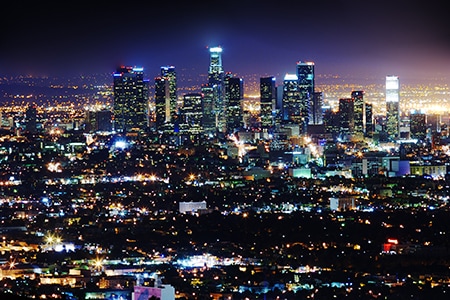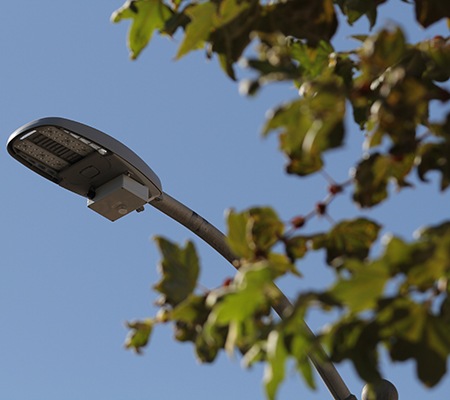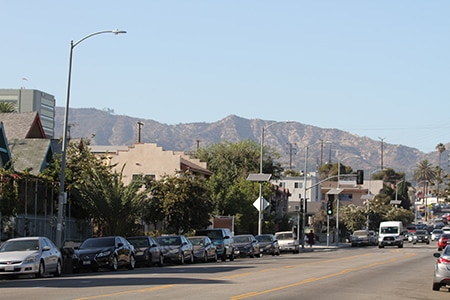- City adds enhanced smart city capabilities, including acoustic sensing and noise monitoring, designed to help improve public services, safety and livability
- Evolving connected lighting applications help city optimize lighting infrastructure investments, delivering value beyond illumination
Somerset, NJ – Philips Lighting (Euronext Amsterdam ticker: LIGHT), the global leader in lighting, today announced that the City of Los Angeles is embarking on a new pilot project to expand its smart city capabilities designed to help improve public safety and support city services for residents, visitors and local businesses.
By leveraging the ubiquity and scale of Los Angeles’s existing connected street lighting infrastructure, Philips Lighting is deploying new technology and Internet of Things (IoT) functionality. This includes sensors mounted on the street poles and software that acquire data, analyze the information, and share insights for more transparent city operations and drive new programs with relevant partners.
For example, new acoustic sensing and environmental noise monitoring sensors can be used to decrease emergency response time and support earlier patient intervention by detecting the sound of a motor vehicle collision and provide timely information directly to the city’s communications dispatch system for police, fire and EMS. Currently, Los Angeles has more than 200,000 street lights throughout the city including roads, highways, tunnels, and walkways, which provide services to benefit citizens.
“Los Angeles’s lighting infrastructure is among the largest in the world and one of our city’s most valuable assets. It is a reliable, omnipresent fixture in the public spaces where people live, work, travel, shop, dine and interact,” said Ed Ebrahimian, director of the Bureau of Street Lighting for the City of Los Angeles. “If we imagine that every light pole can collect all kinds of data points about the city environment and its uses, there is so much more value that street lighting can afford to our citizens in addition to providing illumination.”
“The continued advancement of connected lighting systems is revolutionizing how cities operate, transforming them into information conduits with the capacity to collect and share data and offer new insights that enable, and really drive, the smart city,“ Susanne Seitinger, Global Sub-segment Manager, Professional Systems, Philips Lighting said. “Los Angeles is at the forefront of smart city innovations with a vision for how technology can adapt to the way people and communities interact with their city.”
Last year, the Los Angeles Bureau of Street Lighting began rolling out Philips CityTouch, the connected street lighting management system that uses existing mobile networks and cloud-based technologies to control street lights, monitor status, and accurately analyze how much energy each light is consuming. The new pilot program will expand on these capabilities by including additional sensor nodes and testing new applications so the city can maximize its infrastructure investment.
The pilot program is being implemented this year to evaluate additional sensor-based use cases including:
Environmental Noise Monitoring
New connected, noise-sensing microphone modules will be added to a subset of Philips CityTouch enabled light poles. By continuously collecting data on noise levels, city managers and planners will be able to easily monitor, aggregate and visualize ambient sound in various areas of the city. The data collected will assist in monitoring noise pollution, ensure faster response to noise complaints and eventually improve long-term urban planning decisions.
“We generally have a very rudimentary understanding of how noise and sound propagate in public and open spaces in the city,” said Dietmar Offenhuber, Assistant Professor at Northeastern University. “By attaching sound sensors to street lighting infrastructure, we get for the first time a very articulated and diverse reading of the urban soundscape. This very granular information allows us to understand how the city and the soundscape influence and impact one another.”
Grid Health Monitoring
Philips CityTouch light poles will acquire key power quality parameters continuously and at unprecedented scale, supporting the public lighting department to assess the quality of power supply to its lighting network. Exposing this data to other public departments and utilities will enable grid managers to be quickly informed of outages. This way faults can be restored faster benefiting residents and local businesses alike.
Advanced Maintenance
Connected street lights will provide the Bureau of Street Lighting with luminaire health data to increase maintenance planning effectiveness and cost savings. In the future, coupled with grid health information this aggregated data will enable advanced maintenance models.
For more information on Philips connected lighting for smart cities, visit:



